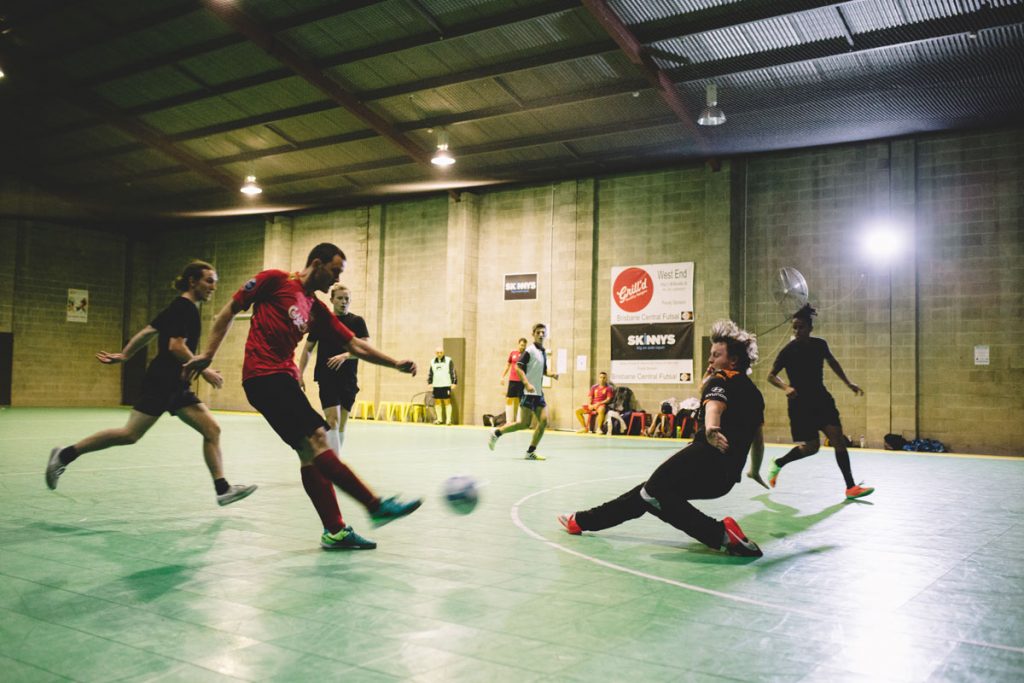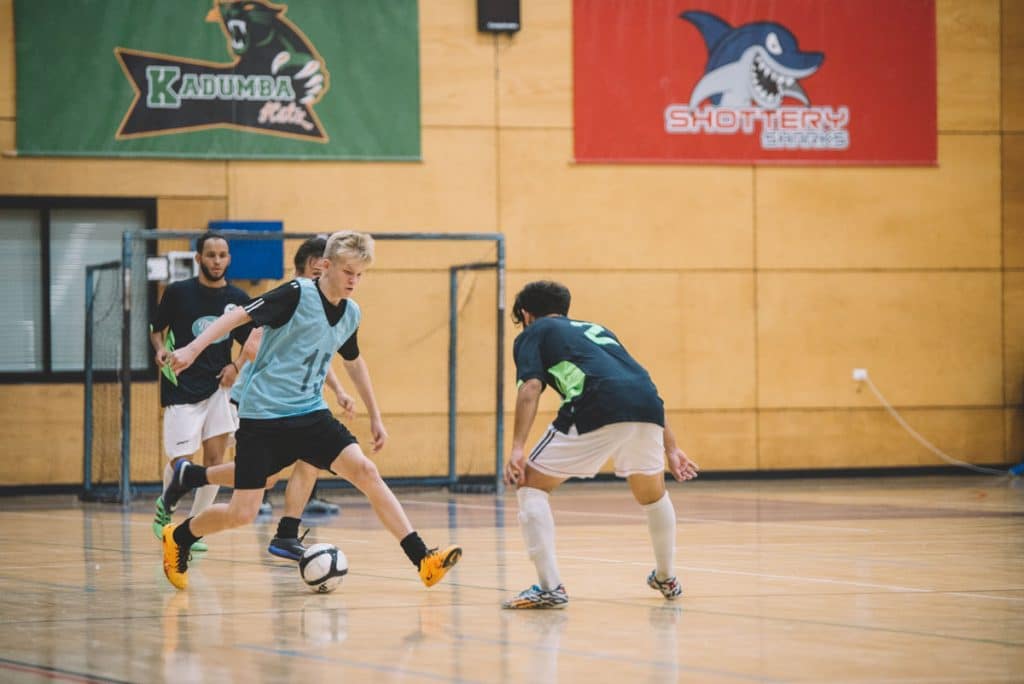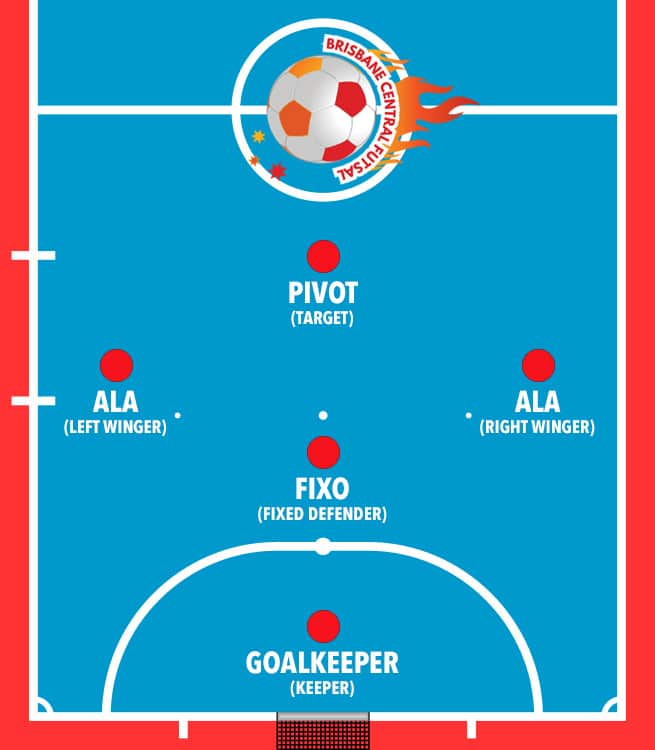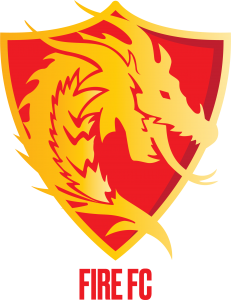WHAT IS FUTSAL?
Futsal is a 5-a-side indoor football game played at club and international level on a basketball-sized court. Whilst it may appear similar to football (soccer, there are a number of distinct differences.
The name Futsal comes from the Spanish fútbol sala or fútbol de salón and from the Portuguese futebol de salão. The term is commonly translated as “indoor football” but a more literal translation is “hall/lounge football”.

WHAT ARE THE DIFFERENCES BETWEEN FUTSAL & SOCCER?
Soccer is normally played as an outdoor game on large fields, whereas Futsal is a type of soccer that is played indoors on a much smaller court. The smaller field size ensures a game of Futsal is fast-paced and more intense, with more opportunity for goal scoring.
Another difference is in the number of players. There are eleven players for each team in the game of Soccer, while Futsal is played with five players on the court. In official competition, a team can have up to 12 squad members. There are three substitutions allowed in a game of Soccer, whereas there are unlimited substitutions in Futsal.
There are many other differences between the two games in terms of tactics, positioning, and the skills required. However, the fundamentals of the two games are essentially similar, making Futsal a great option for Soccer players and vice-versa.
SOCCER
- #5 Sized Ball
- 11 players on field
- 3 substitutions per game
- Throw-in
- Running Clock
- 45 minute halves
- No time-outs
- Goal kicks
- Some contact
- No absolute time limit to restart game
- Offside Rule
- Goalkeeper steps
- Goalkeeper cannot touch by hand a ball kicked back
- Unlimited back passes to Goalkeeper
- No sub for player sent off
- Corner kick placed in arch
FUTSAL
- #4 Ball – 30% less bounce
- 5 players on field
- Unlimited “flying” substitutions (12 Players on a Team)
- Kick-in
- Stopped Clock
- 20 minute halves
1 time-out per half - Goal Clearance (throw)
- No shoulder charges or sliding tackles
- 4-second rule on restarts
- No Offside Rule
- No restrictions, but limited to 4 seconds
- Goalkeeper cannot touch by hand a ball played back
- One back pass to Goalkeeper
- Player sent off can be substituted for after 2 minutes or other has scored
- Corner kick placed on corner
FUTSAL RULES SIMPLIFIED
- APlayers must wear non-marking soled shoes, shin pads covered by long socks and ‘sport’ shirt and shorts (referees can prevent players from entering the court if not dressed correctly)
- Each team has 5 players on the court – one of whom MUST be the goalkeeper
- Team squads can be up to a maximum of 12 players (usually 6 to 8 suffice
- Flying substitutions are allowed throughout the game- without notifying the referee. (G/K’s should only be substituted during a Stoppage in play).
- A goal CANNOT be scored directly from a sideline kick in, an indirect free kick or a kickoff (starting or restarting a game)
- Other than #5 above, a goal may be scored from anywhere on the court (within the necessary rules of the game).
- The whole of the ball must CROSS the whole of the line for the referee to award a corner, goal, goal clearance etc.
- There are NO offsides!
- Slide tackles are NOT allowed in a game of futsal by any players except goalkeepers (see # 18)
- Shoulder charging is NOT allowed.
- Aggressive/Dangerous play is NOT allowed.
- There is a 4 second time limit placed on all set plays (corners, free kicks, etc).
- 5 accumulated team fouls are allowed each half (per team). Each subsequent foul is rewarded by a 10 metre penalty shot to the opposing team.
- To restart the game from the sideline a KICK IN replaces the throw in. Ball placed on the sideline, a player must have both feet on or Outside the sideline.
- To restart the game by a GOAL (kick) CLEARANCE, the goalkeeper must THROW the ball into play.
- During play, a goalkeeper CANNOT throw or dropkick/punt the ball over the 2/3 line on the ‘full’. Allowed in West End & Yeronga competitions.
- Once distributed by the g/k (in his/her own half) the ball may NOT be touched again by him/her until the ball has either touched an Opponent or has crossed the halfway line. (2 Touch) Allowed in West End & Yeronga competitions.
- A goalkeeper may NOT handle the ball from a back pass or kick in and is restricted to 4 seconds on the ball in his/her own half of the field.
- Goalkeepers can only slide (side on) within the confines of their own penalty area. Sliding feet first toward an opponent is illegal (Dangerous play).
- Goalkeepers may only handle the ball within their own penalty areas (“D”s)
- Players must retreat 3 meters from the ball at all ‘set’ plays.
- Players CANNOT play the ball whilst (“lying”) on the ground if an opponent is within playing distance of the ball.
- Referees ALWAYS have the final say in ALL match decisions, please accept those decisions and respect our officials and the difficult job they do! (no refs, no games!)
- Referees control games (if necessary) with BLUE (2 minute timeout), YELLOW (caution) and RED (expulsion) cards.
- Brisbane Central Futsal Judiciary panel is responsible for deciding penalties (match suspensions) for those players found guilty of persistent rule breaking, foul play, dissent etc.

FUTSAL POSITIONS EXPLAINED
Futsal is played with a total of five on-field players per team – one goalkeeper and four outfield players. Substitutes can be used anytime during the match. By nature of the small court size, all players should contribute to both attack and defensive play. However, there is a general rule of thumb when it comes to player positions and roles. How does your team stack up to the theory below?
GOALKEEPER (KEEPER)
A very important position – the goalkeeper plays a vital role in determining the final score. This is often the friend who can’t run or is injured but can still help the team. Having a gun in goals will almost guarantee success at the end of the season and come finals time
FIXO (FIXED DEFENDER)
Most often the captain and/or the team manager of the side. The one who puts in the most effort both on and off the court. The last ditch attempts in defence to not allow the opposition to score and the one who helps out the goalkeeper behind the most. A top shelf Fixo has the team in front well-structured and organised.
ALA (LEFT & RIGHT WINGER)
Two wingers, one on the left and one on the right. These two players are the two workhorses in the team. Usually the fittest two players are designated the role of winger with the idea of helping attack and also getting back to help defend. Fitness is a key requirement the higher the level.
PIVOT (TARGET)
A goal scorer, the one who holds up play, the friend with the strongest shot! The star who attacks more than defends. The team-mate who gets the call-up each week, the one everyone looks to for goals.

Sources:
- https://it.wikipedia.org/wiki/File:FutsalPitchsvg.svg
- http://futsal.com/differences-futsal-soccer/
- https://en.wikipedia.org/wiki/Futsal_positions















